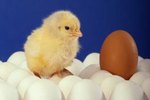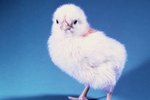
Mealworms are often raised as pet food for lizards, fish and birds. Many fisherman also admire these little wigglers for their lasting power when dangled in the water on the end of a hook. It’s not unusual for people to raise their own mealworms for these reasons, and sometimes it’s only then that people realize that a mealworm isn’t the final stage of an insect, it’s just one stage of a darkling beetle’s development.
Where Mealworms Come From
All mealworms get started when an adult darkling beetle lays her eggs in the soil in and around her home. The eggs stay in the soil for anywhere from a few days to more than a month before they hatch. How long it takes them to hatch depends on how warm and humid the environment is. People who want to raise mealworms keep their cages warmer than room temperature, but 70 to 72 degrees Fahrenheit is okay for mealworms if you aren’t in a hurry. After hatching, each egg releases a tiny mealworm that almost immediately begins to eat.
What Happens Next
Mealworms have exoskeletons, which means their bodies are supported from the outside, not the inside. Since exoskeletons are hard, the mealworms’ skins can’t grow with them, so they shed their skins a few times as they grow in a process called molting. Mealworms that have just molted are usually very pale compared with those whose skins have hardened and turned tan or brown. When they’ve eaten enough, the mealworms are ready to pupate, and they make hard shells around themselves to protect them while they change into beetles. After a week or two, fully grown darkling beetles emerge from the pupae.
What They Eat
Mealworms like all kinds of foods, and some of their favorites have the word “meal” in them. They will eat oatmeal, cornmeal and other grains crushed into meal such as wheat and milo. In the wild, they eat fungus, seeds and decaying plants, but captive mealworms often eat dog or cat food, old cereal, chicken food, birdseed, flour, fruits and vegetables. They are mostly vegetarians, but sometimes they also eat each other, especially if conditions are poor or if they are overcrowded.
Open Wide
Some people think that raising and eating mealworms might be a good way to increase how much protein is available for people to include in their diets. Cattle, pigs and chickens all need lots of space compared to how much room you need to grow a nice crop of mealworms. The mealworms use more energy than you might expect, though. It takes about the same amount of energy to raise a pound of mealworms as it does to raise a pound of pork because the mealworms have to be kept warm all the time or they won’t grow well.
References
Photo Credits
-
Thomas Northcut/Photodisc/Getty Images




